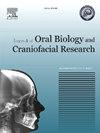Evaluation of pharyngeal airway changes & velopharyngeal function following Le-fort I osteotomy in cleft lip and palate patients- a systematic review & meta analysis
Q1 Medicine
Journal of oral biology and craniofacial research
Pub Date : 2025-06-11
DOI:10.1016/j.jobcr.2025.06.001
引用次数: 0
Abstract
Background
Le-Fort I osteotomy is commonly performed in cleft lip and palate patients to correct maxillary discrepancies, potentially influencing pharyngeal airway dimensions and velopharyngeal function. Thus, the review aims to evaluate the effects on pharyngeal airway and velopharyngeal function following Le-Fort I osteotomy in cleft lip and palate patients.
Method
This systematic review followed the guidelines outlined in the Preferred Reporting Items for Systematic Reviews and Meta-Analysis (PRISMA). A comprehensive electronic search in databases of Scopus, EBSCO, PubMed, Cochrane, CINAHL, ScienceDirect and Google Scholar was performed to identify studies published from inception to August 2024 with language restricted to English. The critical appraisal using NIH quality assessment tool and data extraction processes were carried out independently by two reviewers. A meta-analysis was conducted to determine the effects of Le-Fort I on nasopharyngeal, oropharyngeal and hypopharyngeal airway depth before and after the intervention. Quality was evaluated using GRADE.
Results
Twelve articles were included in this review. Le-Fort I maxillary advancement significantly increases pharyngeal airway dimensions, particularly in the nasopharyngeal and oropharyngeal regions, with most studies reporting improved airway space postoperatively. However, velopharyngeal function outcomes were variable: some patients experienced transient increases in nasalance or hypernasality, while others showed no significant adverse effects. Notably, preoperative hypernasality may predict postoperative velopharyngeal insufficiency.
Conclusion
Le-Fort I maxillary advancement increases pharyngeal airway volume; particularly in the nasopharyngeal and oropharyngeal regions; thereby improving breathing function, especially during sleep. However, the degree of airway expansion varies depending on the extent of surgery and preoperative airway conditions. While the procedure often enhances velopharyngeal closure by improving anatomical alignment and muscle coordination, it also carries a risk of worsening velopharyngeal insufficiency if the maxilla is advanced beyond a certain limit, which differs among individuals.
Le-fort I型截骨术对唇腭裂患者咽气道变化及腭咽功能的评价——一项系统综述和荟萃分析
背景le - fort I型截骨术常用于唇腭裂患者,以纠正上颌差异,可能影响咽气道尺寸和腭咽功能。因此,本文旨在评价Le-Fort I型截骨术对唇腭裂患者咽气道和腭咽功能的影响。方法本系统评价遵循系统评价和荟萃分析首选报告项目(PRISMA)中概述的指南。我们对Scopus、EBSCO、PubMed、Cochrane、CINAHL、ScienceDirect和b谷歌Scholar等数据库进行了全面的电子检索,以确定从成立到2024年8月以英语为语言发表的研究。使用NIH质量评估工具和数据提取过程的批判性评估由两位审稿人独立进行。通过meta分析确定Le-Fort I干预前后对鼻咽、口咽和下咽气道深度的影响。采用GRADE评价质量。结果共纳入12篇文献。Le-Fort I上颌前进显著增加咽气道尺寸,特别是在鼻咽和口咽区域,大多数研究报告术后气道空间改善。然而,腭咽功能结果是可变的:一些患者经历了短暂的鼻平衡或鼻音亢进,而另一些患者则没有明显的不良反应。值得注意的是,术前鼻音增高可以预测术后腭咽功能不全。结论上颌前进可增加咽气道容积;特别是在鼻咽和口咽区域;从而改善呼吸功能,尤其是在睡眠时。然而,气道扩张的程度取决于手术的程度和术前气道状况。虽然该手术通常通过改善解剖排列和肌肉协调来增强腭咽闭合,但如果上颌骨向前超过一定限度,也有恶化腭咽功能不全的风险,这在个体之间是不同的。
本文章由计算机程序翻译,如有差异,请以英文原文为准。
求助全文
约1分钟内获得全文
求助全文
来源期刊

Journal of oral biology and craniofacial research
Medicine-Otorhinolaryngology
CiteScore
4.90
自引率
0.00%
发文量
133
审稿时长
167 days
期刊介绍:
Journal of Oral Biology and Craniofacial Research (JOBCR)is the official journal of the Craniofacial Research Foundation (CRF). The journal aims to provide a common platform for both clinical and translational research and to promote interdisciplinary sciences in craniofacial region. JOBCR publishes content that includes diseases, injuries and defects in the head, neck, face, jaws and the hard and soft tissues of the mouth and jaws and face region; diagnosis and medical management of diseases specific to the orofacial tissues and of oral manifestations of systemic diseases; studies on identifying populations at risk of oral disease or in need of specific care, and comparing regional, environmental, social, and access similarities and differences in dental care between populations; diseases of the mouth and related structures like salivary glands, temporomandibular joints, facial muscles and perioral skin; biomedical engineering, tissue engineering and stem cells. The journal publishes reviews, commentaries, peer-reviewed original research articles, short communication, and case reports.
 求助内容:
求助内容: 应助结果提醒方式:
应助结果提醒方式:


